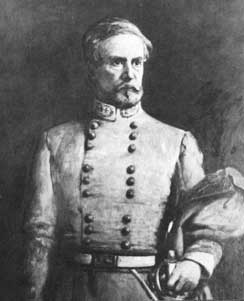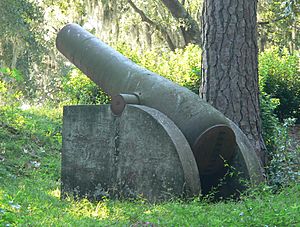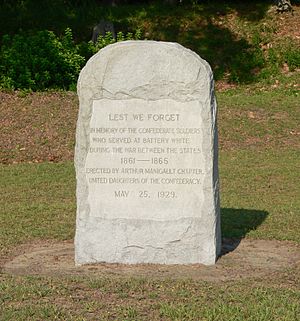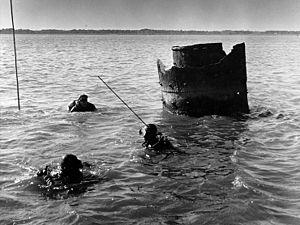Battery White facts for kids
Quick facts for kids |
|
|
Battery White
|
|
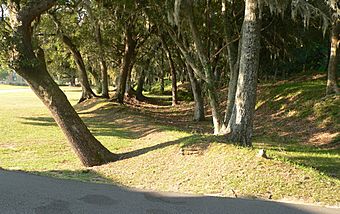
Battery White earthworks. Winyah Bay is out of the photo to the left.
|
|
| Location | 1228 Belle Isle Road |
|---|---|
| Nearest city | Georgetown, South Carolina |
| Built | 1862 |
| NRHP reference No. | 77001222 |
| Added to NRHP | November 16, 1977 |
Battery White was a special fort built by the Confederates during the American Civil War. It was built in 1862–63 to protect Winyah Bay on the South Carolina coast. The fort was very strong and well-built. However, it didn't have enough soldiers. Because of this, it was captured easily in the last months of the war.
Today, Battery White is listed on the National Register of Historic Places. It's on private land, but people can visit it.
Contents
Why Was Battery White Built?
Even before the Civil War started, the leaders in South Carolina worried about attacks from the sea. After South Carolina decided to leave the United States in 1860, they wanted to build forts. These forts would protect Winyah Bay and the Santee River entrance.
Protecting Winyah Bay
Winyah Bay was a very important place.
- It was a safe harbor for many ships.
- The city of Georgetown was the biggest city on the South Carolina coast north of Charleston.
- Georgetown County grew almost half of all the rice in the United States. In 1860, this was about 54 million pounds!
- Georgetown sent out more rice than any other port in the world.
Union forces could easily attack the rivers that flow into Winyah Bay. These rivers included the Black, Pee Dee, Waccamaw, and Sampit. If the Union stopped rice production, it would hurt the local economy. It would also make it harder for the Confederacy to feed its soldiers.
In May 1861, General P. G. T. Beauregard ordered defenses for South Carolina's coast. This included forts on three islands near Winyah Bay: North Island, South Island, and Cat Island.
Changes After Port Royal
When the Union captured Port Royal in November 1861, building these forts became urgent. Robert E. Lee was put in charge of the area. Colonel Arthur Middleton Manigault oversaw the Georgetown area.
These island forts were never attacked by a large Union force. But they were still useful. They helped with ships that got stuck. They also protected the bay entrance and kept the islands under Confederate control.
Confederate Troops Leave the Area
Things changed in early 1862. Robert E. Lee was called back to Richmond. General John C. Pemberton took his place. Pemberton ordered soldiers and cannons to leave the Georgetown area. He wanted to use his limited soldiers to defend shorter lines.
Union Forces Take Advantage
Union ships quickly used this chance. In May 1862, the gunboats USS Albatross and USS Norwich saw that the island forts were empty. They landed soldiers and took over North Island. This became the main Union base in the area. They also destroyed the forts on South and Cat Islands.
The Union ships sailed about 10 miles up the Waccamaw River. They raided a mill and freed 80 enslaved people. These freed people started a community on North Island. It grew to over a thousand people before they were moved to Port Royal for safety.
The Union forces did not try to take land up the rivers. Their trips were limited by how deep their ships could go. But they still made many raids. They damaged buildings, took rice, and freed more enslaved people. These raids really hurt the area's economy. Rice production suffered a lot. It needed many skilled enslaved workers to do tasks at certain times.
Pemberton still refused to send cannons and soldiers to Georgetown. He said all his resources were needed to protect Charleston. But his leaders told him to build new forts at Winyah Bay. Since the Union now controlled the islands, new fort locations were needed further up the bay. On August 3, 1862, Pemberton chose Mayrant's Bluff and Frazier's Point for the new forts.
Building Battery White
Later in August 1862, Pemberton was promoted and sent to a different area. General Beauregard took command on September 24, 1862. He supported building forts at Winyah Bay. On October 8, 1862, he told Governor Pickens that a fort with five or six cannons was being built at Mayrant's Bluff. By November 10, he wrote that the fort was "armed and completed." He also sent new soldiers to General James H. Trapier, who was in charge of the Georgetown area.
Trapier was not happy with the soldiers and cannons he received. The new soldiers arrived without weapons or ammunition. They were also Reserves, meaning they would only serve for 90 days. This was not enough time to train them well. He also got light cannons. He wanted heavy cannons called Columbiads. These were better for defending the fort and bay against strong Union ships.
First Battle at Battery White
Even with few men and weapons, the new fort worked well. On November 11, 1862, two Union gunboats entered Winyah Bay. They started firing at the Mayrant's Bluff fort. The Second South Carolina Artillery, with nine cannons, fired back. Within a few minutes, the Union ships had to leave.
In February 1863, Trapier reported that the Mayrant's Bluff fort, now called Battery White, had only 53 men and nine cannons. Even this small force was enough to stop Union ships from going up the rivers of Winyah Bay. However, rice production in Georgetown did not get better. The raids had destroyed too much and caused too much worry for farmers to grow as much rice as before.
The fort kept losing soldiers, even though Trapier kept asking for more. In October 1864, eleven soldiers left the Confederate German Artillery. They told a Union ship that many soldiers were unhappy and wanted to leave. They also said there were ten cannons at the fort. The Union captain decided the bay was too well defended to help the soldiers leave.
The Capture of Battery White
In November 1864, Trapier was ordered to move most of his soldiers to Mount Pleasant, near Charleston. Only a small group of soldiers was left to defend Georgetown. By the end of January 1865, only a few men led by a lieutenant remained at Battery White.
Sherman's March and Charleston's Fall
In January and early February 1865, Union forces led by General William Tecumseh Sherman marched north from Georgia into South Carolina. They won a battle on February 2 and 3, opening their way into the state. After pretending to attack Charleston, they marched to Columbia, entering it on February 17. On the same day, Charleston was left empty by the Confederates, and on the 18th, it was given up to the Union.
From Charleston, Union naval forces under Admiral John A. Dahlgren moved up the coast to Georgetown. Dahlgren thought Georgetown could be a good place to connect with Sherman's army. On February 23, some soldiers who had left the Confederate army told a Union ship that Battery White had been or would soon be empty. The Union ship fired four shots at the fort. When no one fired back, a group went ashore. They found the fort empty and its cannons broken so they couldn't be used.
Union ships continued up the bay. A group of Marines landed and took over Georgetown. The city leaders officially gave up the city on February 25.
Soon after, Dahlgren looked at Battery White and was very impressed. He wrote that the fort was well-placed and designed. It could defend against both ship attacks and land attacks. Eleven cannons faced the water. These included two large 10-inch Columbiads and other cannons of different sizes. The back of the fort had a strong wall and ditch. There were also places for gunpowder. Dahlgren wrote, "If the works had been sufficiently manned, it would have required good troops to take the work." This means if the fort had enough soldiers, it would have been very hard to capture.
The Sinking of USS Harvest Moon
By late 1864, the Union fleet had stopped most ships from getting into Winyah Bay. So, the Confederates decided to place "torpedoes" (which we now call mines) in the bay. Eighteen mines were built in Georgetown and placed in important spots.
As early as January 1865, Union supporters in Georgetown warned Dahlgren's forces about the mines. While approaching Battery White, a Union ship sent out boats to look for these devices. However, their efforts might not have been careful enough. Dahlgren later wrote that people often didn't take mines seriously.
On the morning of March 1, 1865, Dahlgren's main ship, the USS Harvest Moon, sailed from Georgetown to inspect Battery White. On the way, the ship hit one of the Confederate mines. The mine blew a large hole in the ship, and one sailor died. The ship quickly sank in about 15 feet of water.
Battery White After the War
For over 100 years after the Civil War, Battery White was part of a large property called Belle Isle Plantation. In the late 1800s, the plantation grounds were beautifully designed. The United Daughters of the Confederacy put up a memorial stone at the site in 1929. Around 1946, the plantation gardens, including the fort, were opened to the public. They stayed open until 1974.
In the 1970s, the plantation land was developed into a housing complex. Some parts of the old fort were lost to construction. However, the owners decided to save Battery White itself. In 1977, a 3-acre area around the fort was added to the National Register of Historic Places. In 2008, the site was opened to the public again.
The earth walls of the fort are still mostly well-preserved. The places where gunpowder was stored have fallen apart. This is because the wooden supports inside rotted away. The two large Columbiad cannons have been put back in place. They now point out over Winyah Bay again.
Cannons and the Harvest Moon Today
Three of Battery White's cannons are now in Georgetown. A 24-pound cannon is in front of the National Guard Armory. Two other cannons are in Constitution Park by the Georgetown waterfront.
The Harvest Moon was never brought up from the water. It has slowly sunk deeper into the mud of the bay. In the mid-1960s, the top deck was under about six feet of mud. A group from Georgetown tried to save and fix the ship to make it a tourist attraction. In 1964, the U.S. Navy officially gave up the ship, meaning private groups could try to salvage it. But the attempt failed because there wasn't enough money. As of 2011, the ship's boiler stack could still be seen at low tide.





